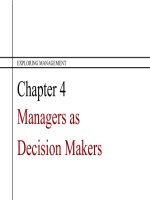Exploring management 3rd ch16
Bạn đang xem bản rút gọn của tài liệu. Xem và tải ngay bản đầy đủ của tài liệu tại đây (795.21 KB, 20 trang )
Exploring Management
Chapter 16
Diversity and
Global Cultures
Chapter 16
• What should we know about diversity in
the workplace?
• What should we know about diversity
among global cultures?
16.1
Diversity in the Workplace
• There is a business case for diversity
• Inclusive organizational cultures value and
support diversity
• Organizational subcultures can create
diversity challenges
• Minorities and women suffer diversity bias in
many situations
• Managing diversity should be a top
leadership priority
DIVERSITY IN THE WORKPLACE
Business and Diversity
• Diversity
– Race, gender, age and many other individual
differences
• Inclusivity
– Degree to which an organization is open to
any one who can perform a job regardless of
race, gender, age or any other individual
difference
DIVERSITY IN THE WORKPLACE
Business and Diversity
• Multi-cultural organization
– Based on pluralism and operates with
inclusivity and respect for diversity
DIVERSITY IN THE WORKPLACE
Business and Diversity
• Organizational subcultures
– Groups that share interests or characteristics
• Occupations
• Ethnicity
• Religion
• Gender
• Generations
DIVERSITY IN THE WORKPLACE
Business and Diversity
• Glass Ceiling
– Career advancement barrier to women and
minorities
DIVERSITY IN THE WORKPLACE
Business and Diversity
• Biculturalism
– Minority members adopt characteristics of
majority cultures in order to succeed.
DIVERSITY IN THE WORKPLACE
Managing Diversity
• Affirmative action
– Management commitment to hiring and
advancing women and minorities
• Valuing differences
– Education and training to understand and
respect differences
• Managing diversity
– Building an inclusive network that allows
everyone to reach his or her potential
DIVERSITY IN THE WORKPLACE
Managing Diversity
16.2
Global Cultures
• Culture shock comes from discomfort in
cross-cultural situations
• Cultural intelligence is the capacity to
adapt to foreign cultures
• The “silent” languages of cultures include
context, time and space
• Hofstede identifies five value differences
among national cultures
• Country clusters show cultural differences
GLOBAL CULTURES
Culture Shock
• Culture shock comes from discomfort in
cross-cultural situations
• Stages include:
Confusion
Small victories
Honeymoon
Irritation and anger
Reality
GLOBAL CULTURES
Cultural Intelligence
• Cultural intelligence includes
– Self awareness
– Flexibility
– Sensitivity
– Willingness to learn
– Willingness to
modify behavior
GLOBAL CULTURES
Cultures
• Low-context
– Emphasize communication via spoken or
written words
• High-context
– Rely on unspoken or situational
cues as well as spoken or
written words in communication
GLOBAL CULTURES
Cultures
• Monochronic
– People tend to do one thing at a time
• Polychronic
– People accomplish many different things at
once
GLOBAL CULTURES
Cultures
• Proxemics
– How people use interpersonal space to
communicate
GLOBAL CULTURES
Culture
• Hofstede’s five value differences among
national cultures:
Power Distance
• The degree to which a society accepts unequal distribution of power
Uncertainty Avoidance
• The degree to which a society tolerates risk and uncertainty
Individualism-collectivism
• The degree to which a society emphasizes individuals and their self-interests
Masculinity-femininity
• The degree to which a society values assertiveness and materialism versus
relationships, feelings and quality of life
Time Orientation
• The degree to which a society values short term or long term goals
GLOBAL CULTURES
Hofstede’s Five Values
GLOBAL CULTURES
Cultures
• Ecological fallacy
– Mistaken belief that a generalization about a
culture applies equally to everyone in that
culture
– Example: does he represent all
Americans?
GLOBE Dimensions
• Power distance
• Uncertainty avoidance
• Gender egalitarianism
• Future orientation
• Institutional collectivism
• In-group collectivism
• Assertiveness
• Performance orientation
• Humane orientation









